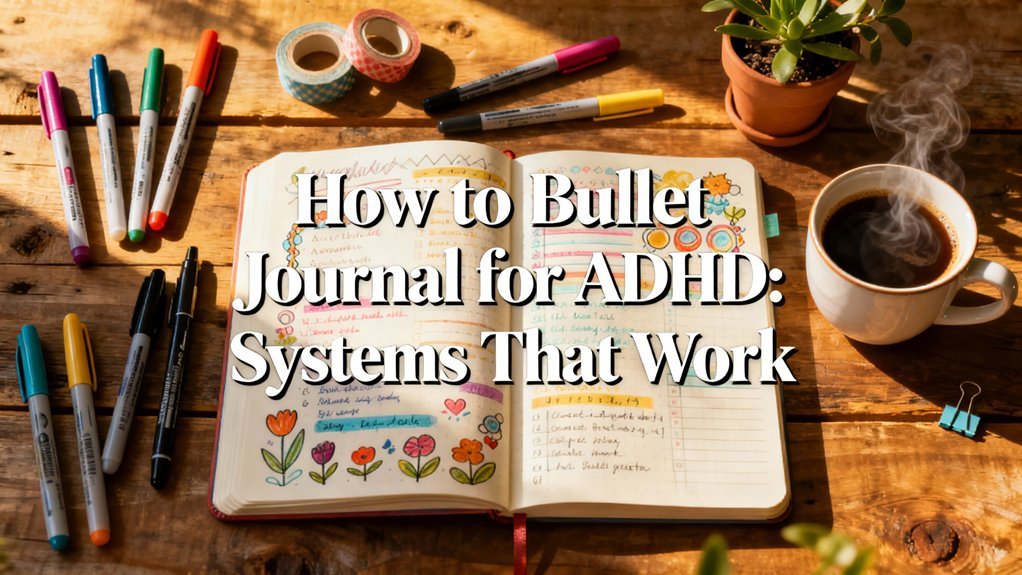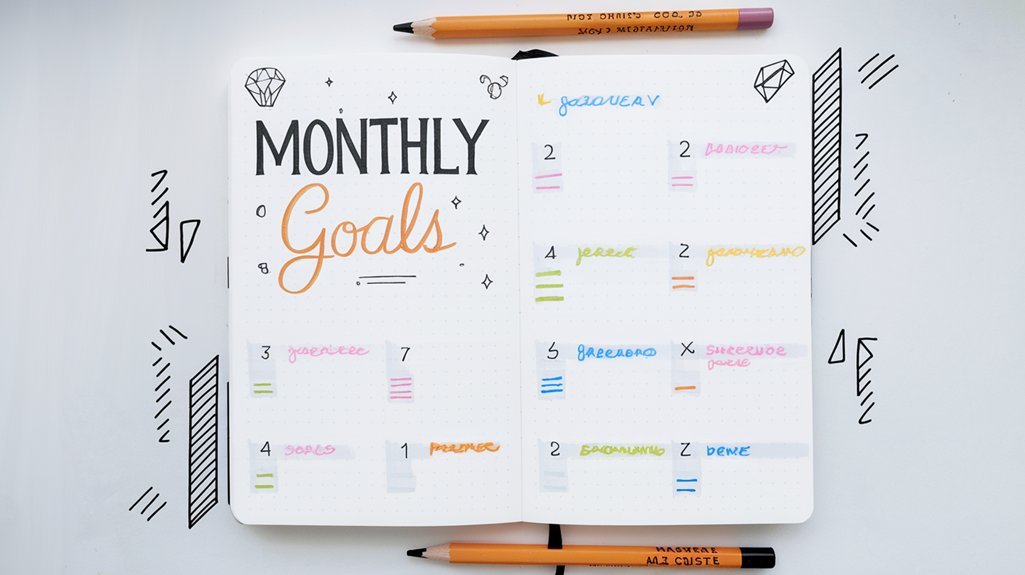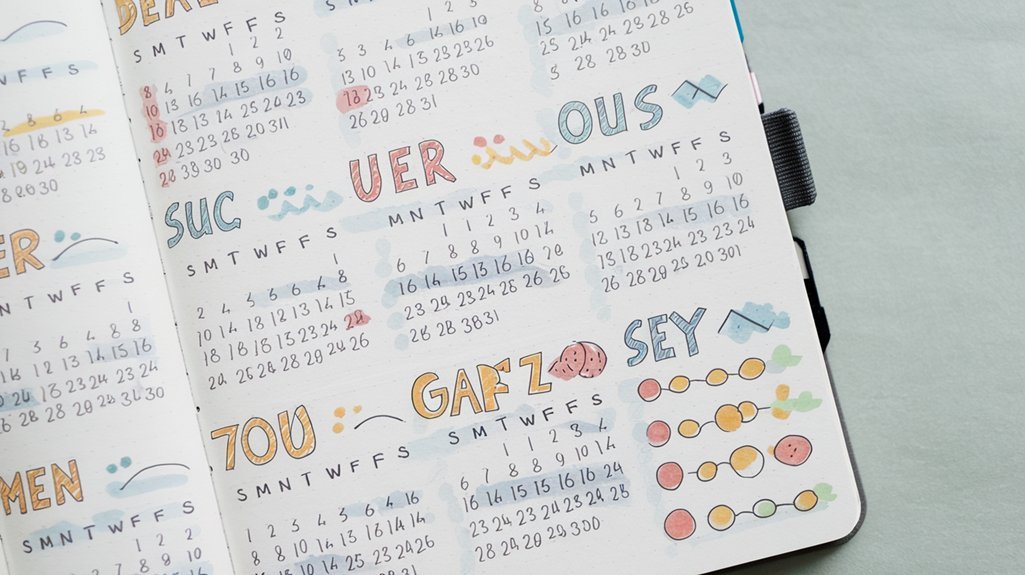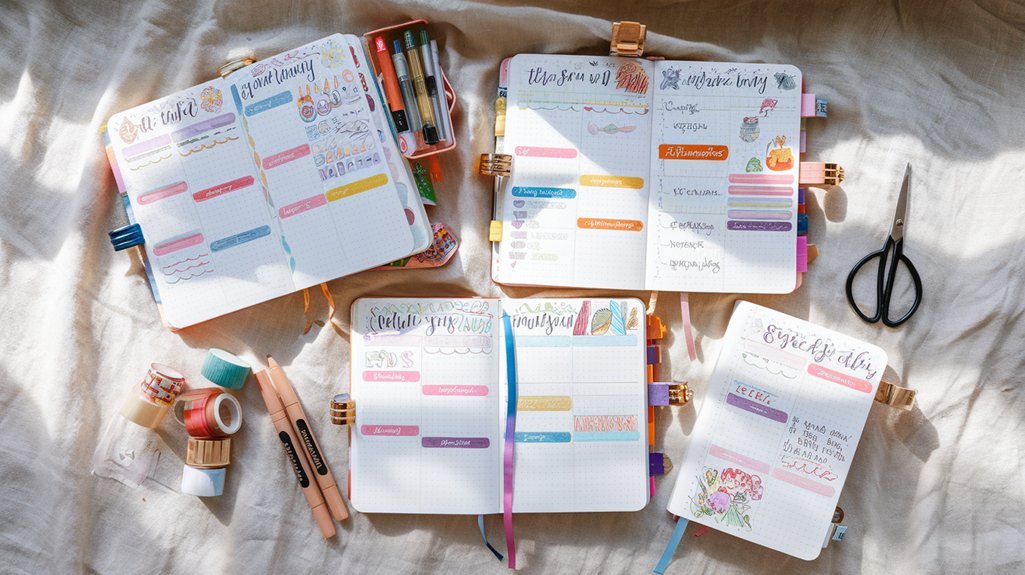Start with just a notebook, pen, and today's date—nothing more. Skip indexing, complex symbols, and migration systems that traditional bullet journaling demands, as these increase cognitive load for ADHD brains. Instead, limit colors to three functional categories, use hour-by-hour time blocks rather than open logs, and build in 5-15 minute change periods between tasks. Your journal should provide immediate visual feedback with minimal steps, not perfect spreads. The key lies in designing a system that works with your executive dysfunction, not against it.
Key Takeaways
- Start with minimal essentials: notebook, pen, and today's date—skip indexing, migration, and elaborate spreads to reduce friction.
- Use hour-by-hour time grids with buffer blocks and alarm reminders to combat time blindness and improve schedule adherence.
- Limit colors to three functional categories with high-contrast shapes for quick visual processing without decision paralysis.
- Build in 5-15 minute transition blocks between tasks as legitimate calendar events to support ADHD processing needs.
- Combine paper journals for rapid logging with digital tools for reminders, creating a hybrid system for working memory support.
Why Traditional Bullet Journals Don't Work for ADHD Brains
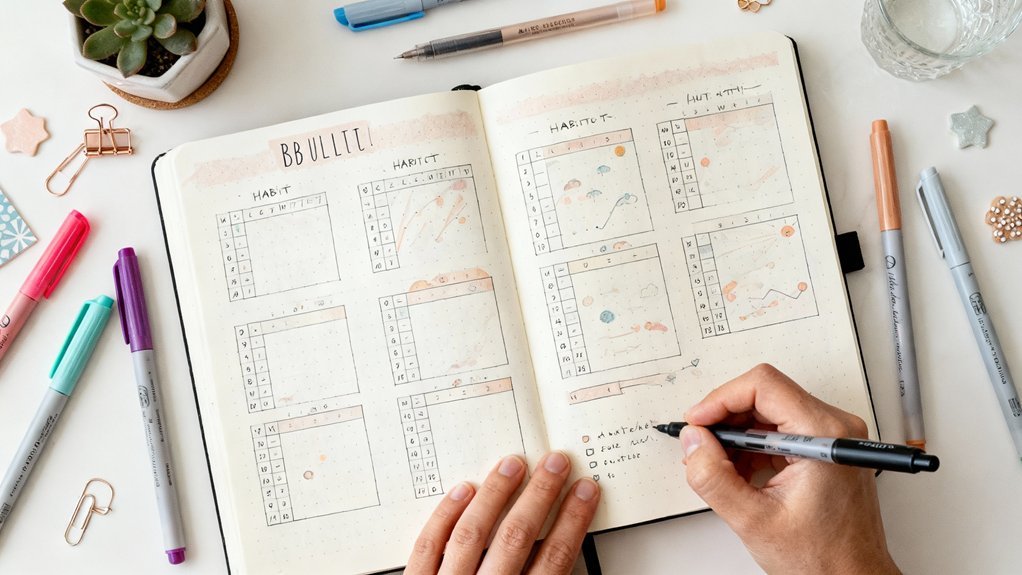
While traditional bullet journaling promises organization and clarity, it inadvertently creates a cognitive minefield for individuals with ADHD. The system's reliance on traditional structures demands consistent daily logging, complex migration processes, and rigid symbol keys—requirements that clash directly with ADHD executive dysfunction.
Your brain struggles with working memory deficits, making it nearly impossible to remember custom symbols or maintain elaborate indexing systems. The traditional method's flexibility challenges become apparent when life disrupts your routine: missed days spiral into weeks of blank pages, triggering shame and abandonment of the entire system.
Research shows ADHD brains require immediate visual feedback and minimal steps between thought and action. Traditional bullet journals demand the opposite—multiple decision points, detailed organization, and sustained attention to maintenance tasks.
The cognitive load required to maintain the system often exceeds its organizational benefits, creating frustration rather than the promised clarity you're seeking.
The Bare Minimum Setup: Starting Simple to Actually Start
Because ADHD brains respond best to systems requiring zero mental overhead, your bullet journal needs just three elements: a notebook, a pen, and today's date at the top of a blank page.
That's it. No elaborate spreads, no color-coding systems, no essential supplies beyond what you already own. Research shows executive dysfunction thrives on complexity—each additional decision point increases abandonment probability exponentially.
Your minimalist layouts should contain only what serves immediate function: tasks you'll complete today, appointments you can't miss, and thoughts requiring external storage. Skip the index, collections, and migration systems initially. These introduce friction that derails momentum before habit formation occurs.
The neuroscience is clear: ADHD brains struggle with initiation but excel at continuation once started. By eliminating setup barriers, you're exploiting this neurological reality. Your first entry doesn't need perfection—it needs existence. Open to any page, write today's date, list three tasks. You've successfully started.
Visual Cues and Color Coding That Support Executive Function

Strategic color application alters your bullet journal from text-based chaos into scannable visual hierarchy—but only when you resist the urge to assign meaning to every hue in your collection.
Your executive function needs visual reminders that register within milliseconds, not elaborate color psychology systems requiring mental translation. Limit yourself to three functional colors: one for time-sensitive items, one for waiting-on-others tasks, and one for priority actions. This constraint prevents decision paralysis while maintaining cognitive efficiency.
Implement high-contrast visual cues through consistent shapes alongside color—boxes for deadlines, arrows for delegated tasks, stars for priorities. This dual-coding approach accommodates color blindness and reduces cognitive load when you're functioning at reduced capacity.
The neurological reality: your brain processes visual patterns faster than text. Each unnecessary color introduces friction between recognition and action.
Your system should reveal information hierarchically, allowing you to extract meaning before consciously deciding to engage with content.
Time Blocking Strategies for Time Blindness
Visual organization means nothing if you can't perceive the hours slipping past while you're hyperfocused on a single task. Time blindness—a core executive dysfunction in ADHD—requires concrete time management strategies within your bullet journal.
Implement hour-by-hour grids rather than open daily logs. Draw vertical lines dividing each page into time blocks, creating visual boundaries that make abstract hours tangible. You'll see exactly how much space 30 minutes occupies versus three hours.
Add time-tracking symbols: circles for tasks started, filled circles for completion, arrows for shifts. This notation reveals your actual productivity patterns versus your perception.
Schedule buffer blocks between commitments—ADHD brains underestimate task duration consistently. Block 15-minute adjustment periods explicitly.
Set alarms aligned with your journal's time blocks. External cues compensate for impaired time perception.
These productivity hacks convert your bullet journal from a record-keeping system into an active time-awareness tool that works with your neurology.
Brain Dump Pages: Capturing Thoughts Before They Disappear
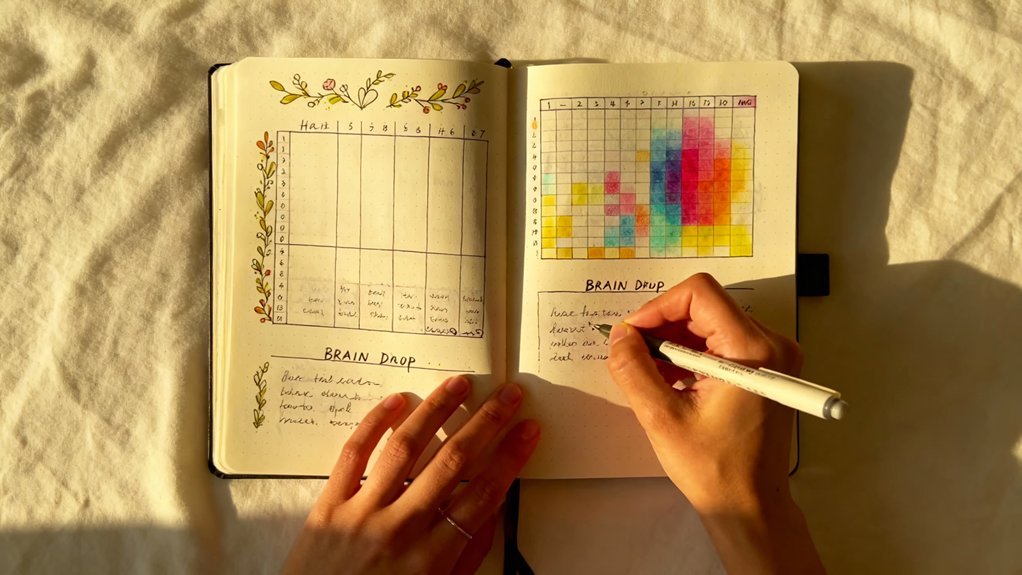
When a thought arrives mid-task, your ADHD brain faces an impossible choice: abandon current focus to record it, or continue working and watch it vanish within seconds.
Brain dump pages solve this neurological dilemma. Designate specific pages in your journal as dedicated capture zones—no formatting, no organization required. The instant a thought intrudes, you've got permission to scribble it down without disrupting your workflow.
Research shows working memory deficits in ADHD mean thoughts genuinely disappear if not externalized immediately. Your brain dump becomes prosthetic memory, holding ideas until you're ready to process them.
Schedule weekly reviews to sort captured thoughts into actionable tasks, reference materials, or discardable noise. This two-step system—immediate capture, delayed thought organization—respects both your need for uninterrupted focus and your brain's tendency to generate ideas at inconvenient moments.
The innovation lies in separating capture from categorization, altering cognitive overwhelm into systematic clarity.
The Two-Minute Daily Reset That Keeps You On Track
Between the chaos of morning urgency and evening exhaustion, your bullet journal risks becoming another abandoned productivity tool—unless you anchor it with a sustainable touchpoint.
The two-minute daily reset functions as your system's failsafe. Set a recurring alarm for your most neurologically available time—often post-lunch or early evening when executive function temporarily stabilizes. During this reset, you'll execute three actions: migrate incomplete tasks forward, mark completed items with dopamine-triggering visual symbols, and identify tomorrow's three non-negotiables.
Set a daily alarm for your neurologically optimal time, then execute three actions: migrate tasks, mark completions, and identify tomorrow's priorities.
This intervention utilizes implementation intentions, which research shows improve task completion by 91% for individuals with executive dysfunction. You're not relying on fragile motivation techniques; you're building automatic behavior through consistent environmental cuing.
The brevity matters critically. ADHD brains abandon complex maintenance rituals. Two minutes prevents decision fatigue while maintaining system integrity. Your journal becomes self-correcting rather than requiring perfect daily devotion—a framework that adapts to your neurology instead of fighting it.
Dopamine-Friendly Reward Systems Built Into Your Pages
Your ADHD brain doesn't respond to delayed gratification—it needs immediate neurochemical feedback to reinforce productive behaviors.
Alter your bullet journal into a dopamine delivery system by integrating visual reward tracking directly onto your pages.
Create habit trackers with satisfying boxes to fill, using bold markers that provide tactile and visual stimulation. Each completed square triggers a small dopamine release, making consistency neurologically rewarding rather than relying on willpower alone.
Design immediate motivation boosts through streak counters, where consecutive days become visually compelling chains you won't want to break. Add color-coded systems that evolve as you progress—perhaps starting with blue markers and graduating to gold when reaching milestones.
Include micro-rewards like stickers, stamps, or washi tape for completed tasks. These tangible acknowledgments bridge the neurochemical gap between action and satisfaction.
Explore pre-created printable spreads designed specifically for tracking habits and rewards, which can save setup time while providing professionally designed layouts that maximize visual appeal.
Your journal becomes a personalized reinforcement machine, working with your brain's chemistry rather than against it.
Managing Hyperfocus and Task Switching With Visual Timers
ADHD brains often struggle with time blindness—the neurological difficulty in perceiving how much time has passed or remains for a task.
Visual timers in your bullet journal create external time awareness that compensates for this executive function deficit, helping you recognize when you've entered hyperfocus and need to shift.
Visual Timer Types Explained
Visual timers convert abstract time into something you can see, making them invaluable tools for managing ADHD-related challenges with time blindness and changes.
Research demonstrates that visual timer benefits extend beyond simple time tracking—they reduce anxiety during shifts and improve task completion rates.
You'll find three primary options: analog disk timers display shrinking red sections, digital countdown timers show numerical progression, and app-based solutions offer hybrid approaches.
Timer customization options matter greatly for ADHD brains. Choose devices allowing multiple preset durations, auditory alerts you can modify, and visual displays sized appropriately for your workspace.
Consider testing different formats. Some individuals respond better to disappearing time segments, while others prefer accumulating bars.
Your best choice depends on whether you're motivated by time remaining or time invested.
Creating Transition Time Blocks
When hyperfocus locks you into a task, shifting away feels nearly impossible—even when you know you're late for something else. Changeover time blocks address this executive function challenge by building buffer zones between activities.
Schedule 5-15 minute intervals explicitly for switching gears. These aren't wasted minutes—they're structured changeover techniques that prevent cascading schedule failures.
In your bullet journal, color-code these blocks differently from work periods. Include specific actions: save files, stretch, set up next workspace.
Research shows ADHD brains require additional processing time for task switching, making this accommodation neurologically sound, not indulgent.
Effective time management means accounting for your actual cognitive needs. When you honor changeover periods as legitimate calendar events, you'll find yourself arriving prepared rather than flustered.
Color-Coding Focus Sessions
How do you know when productive focus crosses into time-distorting hyperfocus? Color-coding focus sessions creates visual boundaries that your ADHD brain can recognize instantly. Assign specific color meanings to different session durations, converting abstract time into concrete visual data.
| Color | Session Duration | Purpose |
|---|---|---|
| Green | 15-25 minutes | Quick tasks, email responses |
| Yellow | 30-45 minutes | Deep work, creative projects |
| Red | 60+ minutes | Hyperfocus alert—check time |
Mark each completed session with its corresponding color. When you see three consecutive red blocks, you've likely bypassed breaks and meals. This pattern recognition helps you identify hyperfocus triggers before executive dysfunction derails your entire schedule. The visual feedback loop strengthens your metacognitive awareness, enabling proactive task switching rather than reactive scrambling.
When to Start Fresh: Embracing Imperfection and Migration
One of the most liberating aspects of bullet journaling with ADHD is recognizing that your system doesn't need to be perfect—it needs to work for you right now.
Your bullet journal doesn't need to be perfect—it just needs to work for you right now.
Research shows that ADHD brains thrive with fresh starts, making migration an essential practice rather than a failure. When your journal feels chaotic or outdated, that's your cue to reset.
Migration Guidelines for ADHD Success:
- Weekly fresh starts allow you to transfer only relevant tasks, naturally filtering out what no longer matters and reducing decision fatigue.
- Embracing flaws in your previous spreads provides diagnostic data—notice which layouts you abandoned to understand what doesn't work for your executive function patterns.
- Mid-month resets are completely valid when your system breaks down; starting a new page costs nothing and restores your functional momentum.
Your bullet journal serves you—not the reverse. When it stops functioning, migrate immediately without guilt.
The Bullet Journal Method is designed to help you slow down and clear mental clutter so you can reconnect with what truly matters in your current circumstances.
Digital-Analog Hybrid Systems for Maximum ADHD Support

While paper journals provide tactile satisfaction and reduce digital distraction, they can't send reminders or sync across devices—two functions ADHD brains desperately need. The solution isn't choosing between systems—it's strategically combining them.
Use your bullet journal for what paper does best: rapid logging, creative layouts, and visual thinking that engages your working memory. Meanwhile, utilize digital tools for their computational strengths: recurring reminders, location-based alerts, and searchable archives.
Here's what works: Calendar events and time-sensitive tasks live digitally where they'll actually ping you. Daily reflections, habit tracking, and project brainstorming happen on paper where analog creativity flourishes.
Your weekly review becomes the bridge—migrate digital completions to your journal and transfer new paper tasks to your reminder system.
This hybrid approach honors both digital organization and tactile engagement, creating redundancy that compensates for ADHD's characteristic working memory limitations.
Frequently Asked Questions
What if I Forget to Check My Bullet Journal Completely?
You'll need external memory aids to remember your journal itself. Set routine reminders on your phone—multiple alarms work best for ADHD brains.
Place your journal where you'll physically encounter it: on your pillow, across your doorway, or taped to your phone. Research shows that environmental cues outperform willpower alone.
You're not failing; your system needs adjustment. Pair journal-checking with an existing habit like morning coffee, and you'll create automatic triggers that don't rely on memory.
How Do I Bullet Journal When Traveling or Away From Home?
You'll never lose track again with a dedicated travel journal that's literally pocket-sized.
Pack portable supplies like a mini notebook, compact pen case, and essential stickers in your carry-on.
Research shows simplified systems work best when you're away—focus on daily logs and critical tasks only.
Your travel journal doesn't need to replicate your home setup; it's your ADHD-friendly command center that adapts to new environments while maintaining your core productivity framework.
Can Bullet Journaling Help With ADHD Medication Tracking and Appointments?
Yes, bullet journaling excels at ADHD medication tracking and appointments.
Create dedicated medication reminders with checkbox systems that provide visual confirmation you've taken doses—critical for executive function challenges.
Design appointment logs with color-coded entries, prescription refill countdowns, and doctor visit summaries.
Research shows external tracking systems greatly improve ADHD medication adherence rates.
You'll reduce missed doses and appointment no-shows while building a thorough health record that improves communication with your healthcare providers.
What if My Handwriting Is Messy or Inconsistent With ADHD?
Your messy handwriting isn't a bug—it's simply part of your ADHD experience.
Research shows consistency matters far less than functionality. You'll find creative solutions like using printed stickers, stamps, or color-coding systems instead of written labels.
Digital hybrid approaches work brilliantly too—photograph pages and add typed notes.
What's essential is capturing information quickly when your brain's ready, not achieving perfect penmanship. Your journal serves you, not Instagram aesthetics.
How Do I Restart After Abandoning My Journal for Weeks?
Skip the guilt—journal abandonment is an ADHD feature, not a failure.
Start fresh on today's page without reviewing what you missed. Research shows that restarting motivation increases when you eliminate “catch-up” pressure.
Simply date a new spread and begin tracking forward. Consider this a system reset, not a relapse.
Your bullet journal works *because* you can restart infinitely. That flexibility is precisely what makes it ADHD-compatible and innovation-ready for your brain's natural rhythms.
Conclusion
Your bullet journal doesn't need to look Instagram-perfect—it needs to work with your brain, not against it. When Sarah, a graphic designer with ADHD, ditched her elaborate spreads for simple checkbox lists and color-coded urgency markers, her task completion jumped from 30% to 75% in three weeks. Start with one page today. Remember: executive dysfunction thrives on complexity but responds beautifully to clarity. Your system should reduce cognitive load, not add to it.

